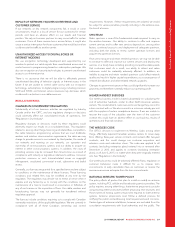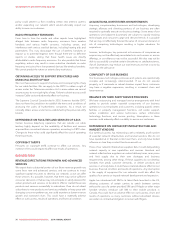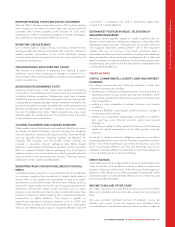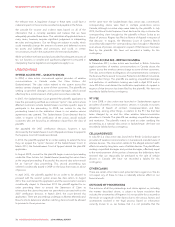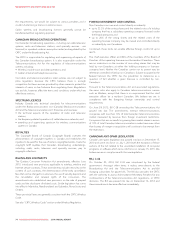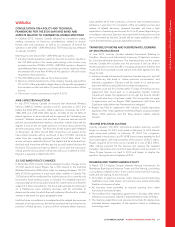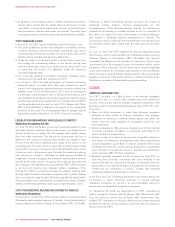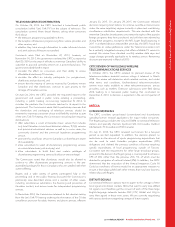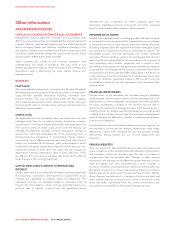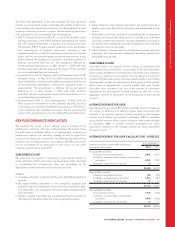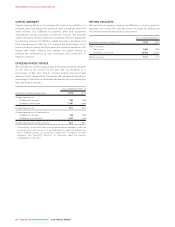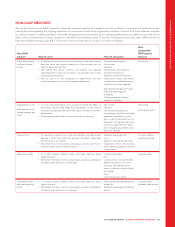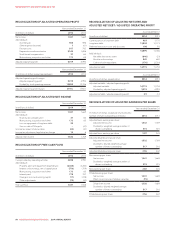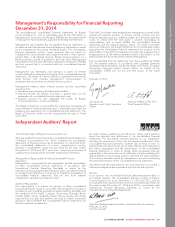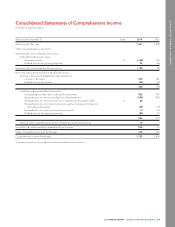Rogers 2014 Annual Report Download - page 83
Download and view the complete annual report
Please find page 83 of the 2014 Rogers annual report below. You can navigate through the pages in the report by either clicking on the pages listed below, or by using the keyword search tool below to find specific information within the annual report.
MANAGEMENT’S DISCUSSION AND ANALYSIS
The table below shows what the impact of an increase or decrease in
the primary assumptions and estimates on our accrued benefit
obligation and pension expense for 2014 would be:
(In millions of dollars)
Increase (decrease)
in accrued
benefit obligation
2014
Increase (decrease)
in pension
expense 2014
Discount rate
Impact of 0.5% increase (141) (15)
Impact of 0.5% decrease 162 16
Rate of future compensation increase
Impact of 0.25% increase 18 3
Impact of 0.25% decrease (18) (3)
Mortality rate
Impact of 1 year increase 35 3
Impact of 1 year decrease (36) (3)
STOCK-BASED COMPENSATION
Stock Option Plans
Our employee stock option plans attach cash-settled share
appreciation rights (SARs) to all new and previously granted options.
The SARs feature allows the option holder to elect to receive in cash an
amount equal to the intrinsic value, instead of exercising the option
and acquiring Class B Non-Voting shares.
We measure stock-based compensation to employees at fair value. We
determine fair value of options using our Class B Non-Voting share
price and option pricing models, and record all outstanding stock
options as liabilities. The liability is marked-to-market in each period
and is amortized to expense using a graded vesting approach over the
period when employee services are rendered, or over the period to
thedateanemployeeiseligibletoretire,whicheverisshorter.The
expense in each period is affected by the change in the price of our
Class B Non-Voting shares during the period.
Restricted Share Unit (RSU) Plan
We record outstanding RSUs as liabilities, measuring our liabilities and
compensation costs based on the award’s fair value, and recording it
as a charge to operating costs over the vesting period of the award. If
the award’s fair value changes after it has been granted and before the
settlement date, we record the resulting changes in the liability as a
charge to operating costs in the year that the change occurs. The
payment amount is established as of the vesting date.
Deferred Share Unit (DSU) Plan
We record outstanding DSUs as liabilities, measuring our liabilities and
compensation costs based on the awards’ fair values at the grant date.
If an award’s fair value changes after it has been granted and before
the settlement date, we record the resulting changes in our liability as a
charge to operating costs in the year that the change occurs. The
payment amount is established as of the exercise date.
JUDGEMENTS
USEFUL LIVES AND DEPRECIATION AND AMORTIZATION
METHODS
We use judgement in choosing methods for depreciating the cost of
property, plant and equipment that we believe most accurately
represent the consumption of benefits derived from those assets and
are most representative of the economic substance of the use of the
underlying assets.
We amortize the cost of intangible assets with finite lives over their
estimated useful lives. We review their useful lives, residual values and
the amortization methods at least once a year.
We do not amortize intangible assets with indefinite lives (spectrum
and broadcast licences) because there is no foreseeable limit to the
period that these assets are expected to generate net cash inflows for
us. We use judgement to determine the indefinite life of these assets,
analyzing all relevant factors, including the expected usage of the
asset, the typical life cycle of the asset and anticipated changes in the
market demand for the products and services that the asset helps
generate. After review of the competitive, legal, regulatory and other
factors, it is our view that these factors do not limit the useful lives of
our spectrum and broadcast licences.
We also use judgement to determine the method over which to
amortize prepayments made for multi-year sports programming rights
agreements (i.e. over the contract term, as aired). We did not make any
significant changes to the amortization method this year.
We will change our depreciation or amortization methods, rates or
asset useful lives if they are determined to be different from our
previous estimates. We recognize the effect of these changes in net
income prospectively.
IMPAIRMENT OF ASSETS
We exercise judgement in determining cash generating units and the
allocation of goodwill for the purpose of impairment testing. The
allocation of goodwill involves considerable management judgement
in determining the cash generating units (or groups of cash generating
units) that are expected to benefit from the synergies of a business
combination. A cash generating unit is the smallest identifiable group
of assets that generates cash inflows that are largely independent of
the cash inflows from other assets or groups of assets. Goodwill and
indefinite life intangible assets are allocated to cash generating units
(or groups of cash generating units) based on the level at which
management monitors goodwill, which is not higher than an operating
segment.
SEGMENTS
We use judgement in determining our operating segments, which are
components that engage in business activities from which they may
earn revenues and incur expenses, for which operating results are
regularly reviewed by our chief operating decision makers to make
decisions about resources to be allocated and assess component
performance, and for which discrete financial information is available.
HEDGE ACCOUNTING
We use judgement in determining whether certain financial
instruments qualify for hedge accounting, including assumptions for
effectiveness valuation models.
INCOME AND OTHER TAXES
We accrue income and other tax provisions based on information
currently available in each of the jurisdictions in which we operate.
While we believe we have paid and provided for adequate amounts of
2014 ANNUAL REPORT ROGERS COMMUNICATIONS INC. 79


